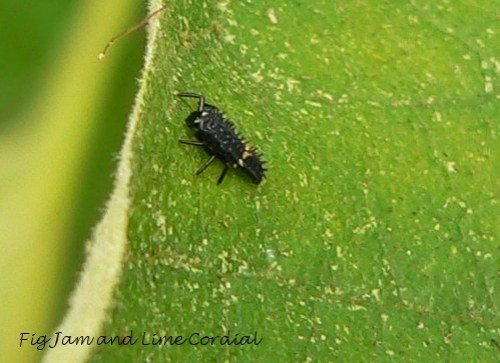
As regular readers will know, our backyard garden has been established following the permaculture principles taught in Linda Woodrow’s book, The Permaculture Home Garden.
One fundamental tenet of the plan is the need for a backyard pond to attract natural predators into the garden. The pond didn’t need to be pretty (Linda points out that a lined tractor tire filled with water would suffice) but ours is, and it provides a constant source of joy to us and our garden visitors.
It’s been fascinating to observe the pest-predator balance adjust itself in our garden. Despite the frustration of watching the fruit fly descend en masse on our defenseless tomato plants, we haven’t used any chemical deterrents. For a couple of weeks, most of the tomatoes in our yard were filled with crawling grubs, and good for nothing more than worm and chook food.
Then the plants and the predators fought back – the plants by suddenly producing more fruit than the pests could eat, and the predators by eating every grub in sight. Despite the heavy losses, we were still able to harvest a more than reasonable crop of roma and cherry tomatoes.

The pond bridge, which we had built to Pete’s design, affords shelter to our Australian rainbow fish. Please excuse the murky photo above, but we’re inordinately proud of our little fish, and I really wanted to show them to you (it’s very hard to autofocus under the water!).
We initially bought six fish for the pond. On the first night, one leapt out of the bucket they were acclimatising in, and when we put the rest of them into the pond, a second one died instantly. We were quite worried about the remaining four – and I was quite concerned about the large quantity of mosquito larvae wriggling in the water.
A few weeks later, all the mosquito larvae were gone. A month after that, the pond was full of tiny fry, swimming in the shallows and hiding in the plant roots. I have no idea if they’ll survive, or what they’re eating, but they’re clearly thriving in their little space!

Having water in the garden attracts a large number of damselflies and dragonflies to our backyard. (Edit: I’ve just found out that the two pictured here are damselflies rather than dragonflies. Apparently damsels hold their wings in when they perch, whereas dragons always have them out.)
We have small multi-coloured ones (above), beigey-green ones (below), large red ones and large orange ones (although I’m yet to successfully photograph the latter two). My camera doesn’t have a working macro setting, so these pics were all taken from a distance and cropped.

Paper wasps are quite prolific in our garden – we used to dislike having them in the backyard, until we realised what amazing predators they are! We experienced our very own David Attenborough moment, as we watched a paper wasp land on a cabbage moth caterpillar, inject it with paralysing poison, then fly off with it to feed her young.

This little beauty is a hoverfly, and I think it alighted on the corn stalk simply to pose for a photo, because I’ve never seen one land before. Its larvae eat aphids and other small pests.

Ladybirds are a welcome visitor to our garden (unlike in parts of the UK, where they’ve reached plague proportions), but I never knew they metamorphed from the most scary looking larvae..



In the garden are a couple of spent broccoli plants, now covered with white fly and other pests. We’ve enjoyed several meals from these plants, but they’re now in their final stages – flowering, stalky and unappealing.

I asked Pete why we hadn’t fed them to the chickens before now. He said that if we left them in the garden, they would attract bees and also help to build up predator numbers, by providing them with plenty of food, at no cost to us. It does seem to be working, as there were at least half a dozen different species buzzing and crawling around the plants, feasting on the pests.
Look at all the aphids on the broccoli leaf! The ladybirds can’t reproduce fast enough…

Permaculture in action – we’re finally starting to understand how all the pieces fit together!